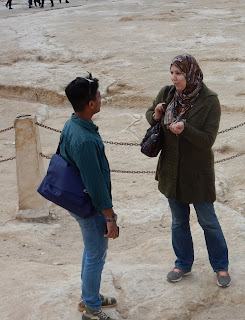 |
| Life along shoreline |
I wake up and look at my phone to determine the location of the boat, I discover that we’re well
on our way to Luxor and will probably be there before noon. Nicola’s upset
because she wanted to see the Temple to Horus or the Horus Temple in Edfu.
Well, that’s not happening now.
We go up
to the deck for coffee but the wind is very cold. We watch the ship pass
through a set of docks and then retreat to our cabin. The shoreline passes by
our window and every so often we jump up to take pictures.
About 50 kilometres south of Luxor, our boat stops in the village of Edsa where the Temple of Khnum is located. We walk several metres down to where it's been excavated and left intact. Khnum
 |
| Temple of Khnum |
After
lunch, we set out for Luxor proper. For some reason, our boat has docked about 25 kilometres from the city proper. We negotiate a deal with a taxi
driver to take us in to Karnak Temple. From there, he negotiates for a horse
drawn carriage to take us to the Luxor Temple about 35 kilometres down the
road. He’ll pick us up at 7:00 to take us back to the boat.
Karnak
Temple encompasses about 2 square kilometres. Only a small portion of grounds
are open to the public which is still huge. It’s the second largest ancient
religious site in the world after Angkor Wat and we got around in a Tuk-tuk in
Angkor Wat so we’re talking huge. It was constructed over two millennia in the city of Thebes started by Sunesret in 1791 BCE, expanded upon by other Pharaohs including Thutmose I and Ramses II ending in 116 BCE with Ptolemy VIII.
 |
| Khnum |
The
actual remnants from the temple have faded and disappeared with time. What you
have left is the temple’s colossal size. Columns covered with carvings rise
21 metres from the floor with a diameter of three metres. And, there are many,
many of them. It’s overwhelming as too, I’m afraid to say, is the number of tourists.
Chinese mostly. I understand they just began coming to this country last year.
Unbelievable.
On our way out of Karnak Temple, we stop to use the WC as
they're referred to over here. As money must pass hands for the purchase of
toilet paper whether its desired or
not, Nicola brings out a 5 Egyptian pound note, worth about 38 cents. That said, we're only getting three pieces of toilet
paper each in exchange. When the guy said it wasn’t enough for the two of us, Nicola took her
note and was about to walk away, a classic tactic for negotiation. As she's walking away, he says, “No, no,” it’s okay. Ridiculous, we'd been reduced to negotiation for the use of the toilet.
Just
outside the Karnak Temple, all the horse and buggies are lined up and so, we’ go
looking for the guy our taxi driver made the deal with. The first driver we
come across, says that person is him. We say, no. He may be a great driver but
he’s not the guy we made the deal with and we don’t want to begin negotiations all over again. So, we
walk past and eventually our original driver emerges from a long line of horse-drawn carriages and drivers.
As we're about to get into his carriage, the first driver starts screaming
at him. At first, we’re confused and then we begin to realize there’s a
protocol with the horse and buggy drivers. They all take turns going next.
We just don't want to get involved and, as our destination, the Luxor Temple, is only 30 minutes walk away,
 |
| Karnak Temple - Amazing |
we leave. Next thing we know the original driver is calling
to us from the carriage. We hesitate but eventually get in. Within minutes of starting out, I realize that the driver and his horse have a very dynamic relationship. After he gives the horse a
little whip with the reins and the horse responds with a two-footed boot to the front of
the carriage. My feelings about making use of his services become conflicted. I realize that the life of this horse and that of many others, must not be very pleasant. That said, without carriage drivers, there would be no horses. Hmm.













Comments
Post a Comment